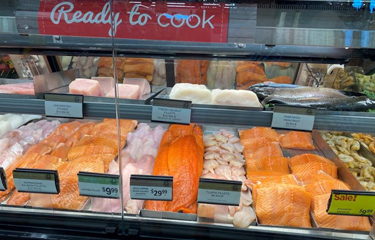High inflation continues to impact fresh seafood sales in U.S. grocery stores, but sales of canned and pouched seafood are rising as shoppers cut costs.
Inflation on fresh seafood was down slightly in June compared to the past two months, but was still up 10.9 percent on average per unit for the month.
Frozen seafood sales were also negatively impacted by rising inflation in June, but not as severely as fresh sales, according to new data from IRI and 210 Analytics.
The average price for finfish jumped to above USD 10.00 (EUR 9.92) per unit, an increase of 21.3 percent versus June 2021. In response, fresh seafood sales plunged 13.3 percent to USD 502 million (EUR 498 million) in June, more than the deceleration of 11.7 percent seen during the entire second quarter, 210 Analytics Principal Anne-Marie Roerink told SeafoodSource.
In Q2 2022, overall fresh seafood prices jumped 12.2 percent to USD 9.47 (EUR 9.40) per unit on average. The average cost of tilapia rose 40.2 percent in the quarter, while catfish prices jumped 22.7 percent, tuna prices ramped up 22.1 percent, scallop prices increased 18.5 percent, cod prices rose 18.4 percent, and salmon prices increased 17.6 percent.
Inflation is also impacting frozen seafood sales, though frozen seafood sales reached USD 520 million (EUR 516 million) in June, outpacing fresh retail sales.
“While frozen seafood remained the biggest seller within animal protein, its dollar sales were down 7.4 percent, whereas all other [frozen] areas grew,” Roerink said.
However, Americans’ cost-cutting efforts in response to inflation are having a positive impact on sales of shelf-stable seafood, as total shelf-stable category reached sales of USD 209 million (EUR 207 million) in June 2022. Shelf-stable seafood had the lowest inflation in June at 8.8 percent and an average per-unit cost of USD 2.08 (EUR 2.06). This resulted in an increase in sales of 9 percent in the second quarter of 2022 and a 7.8 percent year-over-year rise in sales in June.
“Ambient seafood sales often do well during times of inflation and uncertainty. Today’s marketplace is no exception,” Roerink said. “June marks fifth-consecutive month of year-on-year dollar growth for ambient seafood.”
Rapidly rising inflation across the grocery store is largely to blame for the change in consumers’ buying decisions, Roerink said.
“The rate of inflation is still accelerating for most areas in the store, including seafood, ticking up by about half to a full percent every month. I believe it is this total pressure on income that is hurting seafood sales, in addition of course, to the inflation seen within seafood itself,” she said.
Ninety-three percent of Americans are concerned about inflation and 81 percent are applying money-saving measures, according to IRI’s June consumer shopping habits survey. And 96 percent of consumers say they are paying somewhat or a lot more for grocery items than they did last year, the survey found.
“Seafood is not known as a cost-effective item. In fact, many Americans see it as more of a premium meal,” Roerink said.
Across all departments of the grocery store, shoppers are pulling back into “familiar patterns of savings,” Reorient noted.
“This includes things like ground beef with higher fat content, potatoes and onions, center-store grocery, as well as finding ways to stretch the total grocery dollar,” she said.
Eighty-one percent of grocery shoppers made changes to what and where they purchased in June, up from 50 percent in the fall of 2021, according to IRI’s June shopper survey.
Changes include looking for sales specials (54 percent), skipping non-essentials (45 percent), finding coupons (33 percent), and buying more private or other low-cost brands (29 percent).
Sales specials, while popular, are still far below pre-pandemic levels and consumers are taking notice, according to Roerink. Nearly 60 percent say fewer of the items they want are on sale and 43 percent say items are not discounted as much as they used to be.
In addition, 51 percent of shoppers are stocking up on certain items more than usual – 18 percent out of fear they will not be available next time and 26 percent out of concern that prices may rise further.
Photo courtesy of 210 Analytics







